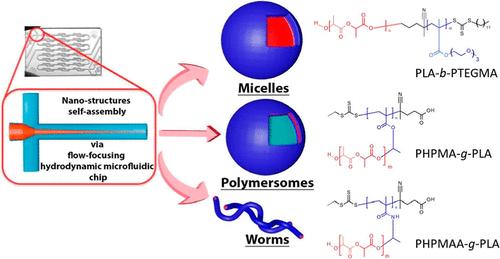Microfluidic Controlled Self-Assembly of Polylactide (PLA)-Based Linear and Graft Copolymers into Nanoparticles with Diverse Morphologies
IF 4.7
Q1 POLYMER SCIENCE
引用次数: 0
Abstract
This study outlines the microfluidic (MF) controlled self-assembly of polylactide (PLA)-based linear and graft copolymers. The PLA-based copolymers (PLA-Cs) were synthesized through a convenient one-pot/one-step ROP/RAFT technique. Three distinct vinyl monomers─triethylene glycol methacrylate (TEGMA), 2-hydroxypropyl methacrylate (HPMA), and N-(2-hydroxypropyl) methacrylamide (HPMAA) were employed to prepare various copolymers: linear thermoresponsive polylactide-b-poly(triethylene glycol methacrylate) (PLA-b-PTEGMA), graft pseudothermoresponsive poly[N-(2-hydroxypropyl)] methacrylate-g-polylactide (PHPMA-g-PLA), and graft amphiphilic poly[N-(2-hydroxypropyl)] methacrylamide-g-polylactide (PHPMAA-g-PLA). The MF technology was utilized for the controlled self-assembly of these PLA-based BCs in a solution, resulting in a range of nanoparticle (NP) morphologies. The thermoresponsive PLA-b-PTEGMA diblock copolymer formed thermodynamically stable micelles (Ms) through kinetically controlled assemblies. Similarly, employing MF channels led to the self-assembly of PHPMA-g-PLA, yielding polymersomes (PSs) with adjustable sizes under the same solution conditions. Conversely, the PHPMAA-g-PLA copolymer generated worm-like particles (Ws). The analysis of resulting nano-objects involves techniques such as transmission electron microscopy, dynamic light scattering investigations (DLS), and small-angle X-ray scattering (SAXS). More specifically, the thermoresponsive behavior of PLA-b-PTEGMA and PHPMA-g-PLA nano-objects is validated through variable-temperature DLS, TEM, and SAXS methods. Furthermore, the study explored the specific interactions between the formed Ms, PSs, and/or Ws with proteins in human blood plasma, utilizing isothermal titration calorimetry.

基于聚乳酸 (PLA) 的线性和接枝共聚物通过微流体控制自组装成具有不同形态的纳米颗粒
本研究概述了基于聚乳酸(PLA)的线性和接枝共聚物的微流体(MF)控制自组装。聚乳酸基共聚物(PLA-Cs)是通过方便的一锅/一步 ROP/RAFT 技术合成的。采用三种不同的乙烯基单体--甲基丙烯酸三乙二醇酯(TEGMA)、甲基丙烯酸羟丙酯(HPMA)和 N-(2-羟丙基)甲基丙烯酰胺(HPMAA)来制备各种共聚物:线性热发性聚乳酸-b-聚(甲基丙烯酸三乙二醇酯)(PLA-b-PTEGMA)、接枝假热发性聚[N-(2-羟基丙基)]甲基丙烯酸酯-聚乳酸(PHPMA-g-PLA)和接枝两性聚[N-(2-羟基丙基)]甲基丙烯酰胺-聚乳酸(PHPMAA-g-PLA)。利用 MF 技术在溶液中对这些聚乳酸基生物碱进行受控自组装,从而产生了一系列纳米粒子(NP)形态。热致伸缩聚乳酸-b-PTEGMA 二嵌段共聚物通过动力学控制的组装形成了热力学稳定的胶束(Ms)。同样,在相同的溶液条件下,利用 MF 通道可实现 PHPMA-g-PLA 的自组装,产生尺寸可调的聚合体(PS)。相反,PHPMAA-g-PLA 共聚物则产生了蠕虫状颗粒(Ws)。对所产生的纳米物体的分析涉及透射电子显微镜、动态光散射研究(DLS)和小角 X 射线散射(SAXS)等技术。更具体地说,通过变温 DLS、TEM 和 SAXS 方法验证了聚乳酸-b-PTEGMA 和 PHPMA-g-PLA 纳米物体的热致伸缩行为。此外,该研究还利用等温滴定量热法探讨了所形成的 Ms、PSs 和/或 Ws 与人体血浆中蛋白质之间的特定相互作用。
本文章由计算机程序翻译,如有差异,请以英文原文为准。
求助全文
约1分钟内获得全文
求助全文

 求助内容:
求助内容: 应助结果提醒方式:
应助结果提醒方式:


